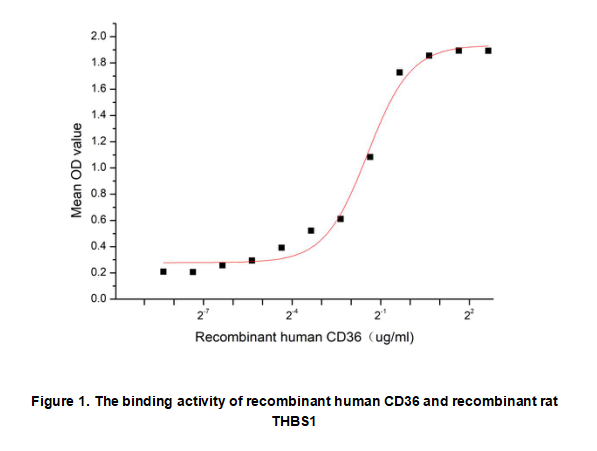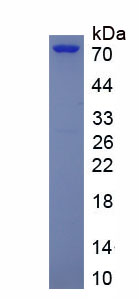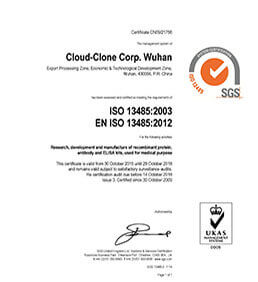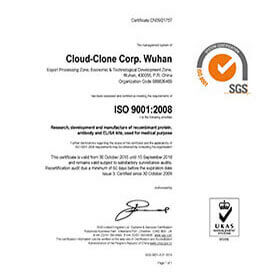Active Cluster Of Differentiation 36 (CD36)
GP4; FAT; GP3B; GPIV; PASIV; SCARB3; GP88; GpIIIb; Glycoprotein IIIb; Collagen Type I Receptor; Thrombospondin Receptor; Fatty acid translocase; Platelet collagen receptor
- Product No.APB530Hu61
- Organism SpeciesHomo sapiens (Human) Same name, Different species.
- Buffer FormulationPBS, pH7.4, containing 5% Trehalose.
- Traits Freeze-dried powder
- Purity> 90%
- Isoelectric Point7.7
- ApplicationsCell culture; Activity Assays.
- DownloadInstruction Manual
- UOM 10µg50µg 200µg 1mg 5mg
- FOB
US$ 220
US$ 550
US$ 1100
US$ 3300
US$ 8250
For more details, please contact local distributors!
ACTIVITY TEST

The cluster of differentiation 36(CD36) is an 88 kDa transmembrane glycoprotein which is known also as SCARB3, member 3 (SR-B3),fatty-acid translocator (FAT), glycoprotein 4 (GPIV) and PAS4. It is a member of a superfamily of scavenger receptor proteins class B, and functions as a receptor mediating the binding and chas multiple biological functions that may be important in inflammation and in the pathogenesis of metabolic diseases, including diabetes.It has been reported that THBS1 can mediate its antiangiogenic activity through CD36 to inhibit tumor angiogenesis, thus a binding ELISA assay was conducted to detect the interaction of recombinant human CD36 and recombinant rat THBS1. Briefly, biotin-linked CD36 were diluted serially in PBS, with 0.01% BSA (pH 7.4). Duplicate samples of 100μl were then transferred to THBS1-coated microtiter wells and incubated for 1h at 37℃. Wells were washed with PBST 3 times and incubation with Streptavidin-HRP for 30min, then wells were aspirated and washed 5 times. With the addition of substrate solution, wells were incubated 15-25 minutes at 37℃. Finally, add 50µl stop solution to the wells and read at 450nm immediately. The binding activity of recombinant human CD36 and recombinant rat THBS1 was shown in Figure 1, the EC50 for this effect is 0.37ug/mL.
USAGE
Reconstitute in 10mM PBS (pH7.4) to a concentration of 0.1-1.0 mg/mL. Do not vortex.
STORAGE
Avoid repeated freeze/thaw cycles. Store at 2-8°C for one month. Aliquot and store at -80°C for 12 months.
STABILITY
The thermal stability is described by the loss rate. The loss rate was determined by accelerated thermal degradation test, that is, incubate the protein at 37°C for 48h, and no obvious degradation and precipitation were observed. The loss rate is less than 5% within the expiration date under appropriate storage condition.
GIVEAWAYS
INCREMENT SERVICES
-
 BCA Protein Quantification Kit
BCA Protein Quantification Kit
-
 Molecular Mass Marker for Protein
Molecular Mass Marker for Protein
-
 Monoclonal Antibody Customized Service
Monoclonal Antibody Customized Service
-
 Polyclonal Antibody Customized Service
Polyclonal Antibody Customized Service
-
 Protein Activity Test Experiment Service
Protein Activity Test Experiment Service
-
 Electrophoretic Mobility Shift Assay (EMSA) Experiment Service
Electrophoretic Mobility Shift Assay (EMSA) Experiment Service
-
 Buffer
Buffer
-
 Lentivirus Packaging Experiment Service
Lentivirus Packaging Experiment Service
-
 Adenovirus Packaging Experiment Service
Adenovirus Packaging Experiment Service
-
 Real Time PCR Experimental Service
Real Time PCR Experimental Service
-
 Spike RBD Protein (S-RBD)
Spike RBD Protein (S-RBD)
-
 Protein G
Protein G
-
 Protein A
Protein A
| Magazine | Citations |
| British Journal Of Nutrition | Fatty acid transport receptor soluble CD36 and dietary fatty acid pattern in type 2 diabetic patients: a comparative study Pubmed:29359682 |
| Immunobiology | Discovering novel lung cancer associated antigens and the utilization of their autoantibodies in detection of lung cancer Pubmed: 31839396 |







